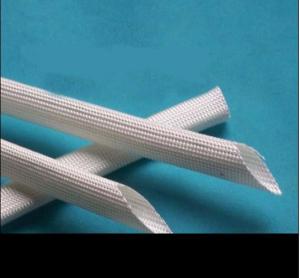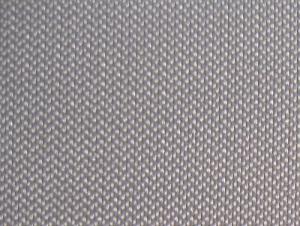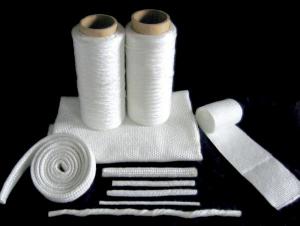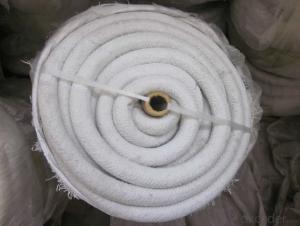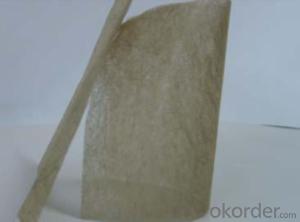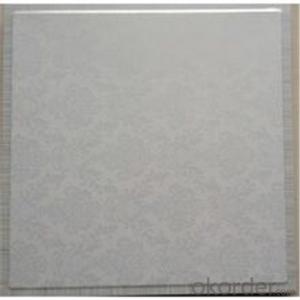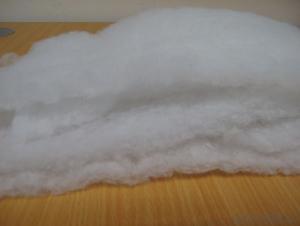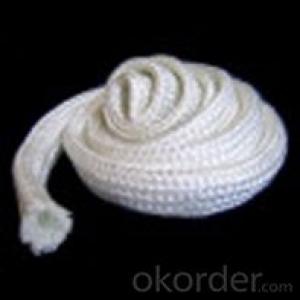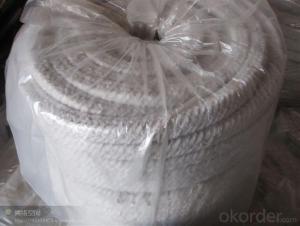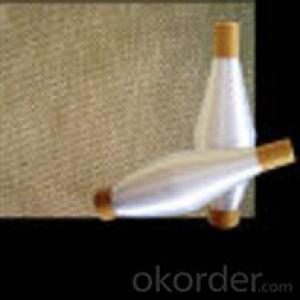Textured Fiberglass Sleeving
- Loading Port:
- China Main Port
- Payment Terms:
- TT or L/C
- Min Order Qty:
- 10 Tons kg
- Supply Capability:
- 2*20FCL Per Month kg/month
OKorder Service Pledge
OKorder Financial Service
You Might Also Like
general infomation of Textured Fiberglass Sleeving
Textured fiberglass sleeving is braided by the textured fiberglass yarn without core. It can be used as fire protection of cable or wire covering.
Characteristics of Fiberglass Sleeving
Cost-efficient high temperature performance
Texturized Fiberglass Sleeve is a heavy wall braided glass fiber sleeve capable of operating at a continuous temperature of 1000F (538C). High bulk fiber construction gives excellent insulation properties, and the texturized, untreated construction allows Thermosleeve to exhibit excellent dielectric strength and resistance to thermal conductivity.
specification of Textured Fiberglass Sleeving
Inner diameter: 13mm-75mm (1/2"-3")
Thickness: 1.5mm-3mm (3/50"-1/8")

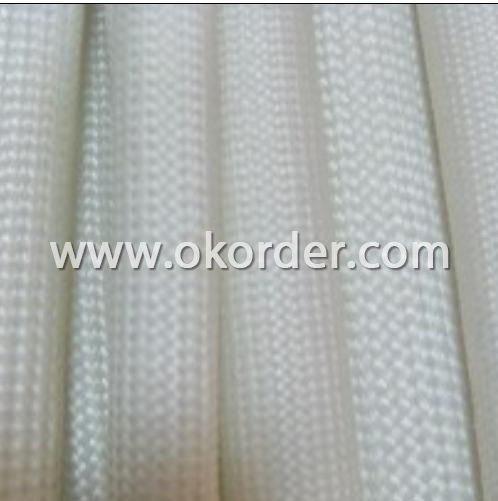
- Q:How do glass fiber textiles perform in terms of dimensional stability?
- Glass fiber textiles are renowned for their remarkable dimensional stability. This quality implies that they remain unaffected by external forces or environmental conditions, maintaining their size and shape. The composition of glass fibers, created by drawing molten glass into thin strands, grants them inherent strength and rigidity. Consequently, glass fiber textiles withstand extreme temperatures, moisture, and mechanical stress without losing their form or size. The low thermal expansion coefficient of glass fiber textiles contributes to their dimensional stability. This indicates that they do not significantly expand or contract when exposed to heat or cold, making them ideal for applications requiring precise dimensions. Furthermore, glass fibers possess high tensile strength, enabling them to resist stretching or elongation when subjected to pulling forces. This characteristic further enhances their dimensional stability. Glass fiber textiles also possess excellent resistance to moisture absorption, preventing swelling or shrinkage when exposed to humidity or water. This quality proves particularly crucial in applications where dimensional accuracy is paramount, such as in the construction of composite materials or reinforcement in structures. Overall, glass fiber textiles exhibit exceptional dimensional stability, positioning them as the preferred choice in industries like aerospace, automotive, construction, and marine. Their ability to maintain their size and shape under diverse conditions ensures dependable performance and longevity in demanding applications.
- Q:Can glass fiber textiles be used in 3D printing?
- Yes, glass fiber textiles can be used in 3D printing. Glass fiber reinforced materials are commonly used in additive manufacturing processes to enhance the mechanical properties of the printed objects. The addition of glass fiber textiles to the printing material can increase the strength, stiffness, and heat resistance of the printed parts. This makes them suitable for applications that require high strength and durability, such as automotive parts, aerospace components, and industrial machinery. However, it is important to note that using glass fiber textiles in 3D printing may require special modifications to the printing process, such as using larger nozzles and adjusting the printing parameters to accommodate the fibers.
- Q:Can glass fiber textiles be used for making geotextiles or erosion control products?
- Yes, glass fiber textiles can be used for making geotextiles or erosion control products. Glass fiber textiles are known for their high strength and durability, making them suitable for applications that require resistance to extreme weather conditions, chemical exposure, and mechanical stress. Geotextiles and erosion control products are designed to stabilize soil, prevent erosion, and reinforce structures in civil engineering and construction projects. Glass fiber geotextiles offer excellent tensile strength and dimensional stability, making them effective in preventing soil erosion and providing reinforcement to soil structures. These textiles can be used in various applications such as retaining walls, embankments, roadways, and drainage systems. Additionally, glass fiber textiles have low elongation, meaning they do not stretch or deform easily under load, ensuring long-term effectiveness. Therefore, glass fiber textiles are a viable option for making geotextiles or erosion control products due to their strength, durability, and resistance to environmental factors.
- Q:Can glass fiber textiles be used in agriculture?
- Yes, glass fiber textiles can be used in agriculture. They can be utilized for various purposes such as crop protection, greenhouse construction, and filtration systems. Glass fiber textiles offer benefits like durability, resistance to chemicals and UV rays, as well as good insulation properties, making them suitable for agricultural applications.
- Q:Can glass fiber textile be used in tennis rackets?
- Yes, glass fiber textile can be used in tennis rackets. Glass fiber textiles, also known as fiberglass, are commonly used in the construction of tennis rackets. The glass fibers are woven into a fabric and then incorporated into the racket frame to provide added strength and stability. This material helps to enhance the durability and performance of the racket, making it more resistant to breaks and bends during intense gameplay. Additionally, the use of glass fiber textile can also contribute to the overall lightweight nature of the racket, allowing players to maneuver and swing with ease. Overall, glass fiber textile is a popular choice for tennis racket construction due to its favorable properties and ability to enhance the playing experience.
- Q:Can glass fiber textiles be used for making hats or headwear?
- Glass fiber textiles, also known as fiberglass, possess the capability to create hats and headwear. These textiles are lightweight and durable, allowing for their transformation into fabric-like structures. With their remarkable strength-to-weight ratio, they prove suitable for a range of applications, including headwear. By utilizing fiberglass in the construction of hats or headwear, one can ensure protection against impact, heat, and even electrical hazards. Moreover, fiberglass textiles can undergo coating or treatment processes to bolster their resistance against chemicals, UV rays, and fire, thereby enhancing safety and durability. Nonetheless, it is crucial to bear in mind that fiberglass can cause skin irritation if not adequately enclosed. Therefore, it is of utmost importance to ensure that hats or headwear made from this material are designed with a comfortable lining or coating to prevent direct contact with the skin.
- Q:Can glass fiber textiles be used in reinforcement of basalt fibers?
- Indeed, the inclusion of glass fiber textiles as reinforcement for basalt fibers is feasible. Recognized for their notable robustness and rigidity, glass fiber textiles are well-suited for reinforcement purposes. In contrast, basalt fibers possess exceptional resistance against elevated temperatures and chemical corrosion. By amalgamating these two materials, the resultant composite can exhibit an unparalleled amalgamation of attributes, including remarkable strength, resistance to high temperatures, and heightened durability. Consequently, glass fiber textiles present a viable alternative for reinforcing basalt fibers in diverse sectors, encompassing construction, automotive, and aerospace industries.
- Q:Can glass fiber textiles be used in prosthetics?
- Glass fiber textiles, known as fiberglass, have the potential to be utilized in prosthetics. These materials are lightweight and robust, making them suitable for reinforcing various sections of prosthetic devices. Prosthetic sockets, which act as the connection between the residual limb and the prosthetic device, frequently employ glass fiber textiles. This utilization enhances both the strength and longevity of the sockets, while also ensuring a comfortable and secure fit for the user. Moreover, glass fiber textiles can be used in the production of other prosthetic device components, including structural supports and cosmetic covers. Overall, the integration of glass fiber textiles in prosthetics offers a multitude of advantages and has become a prevalent practice in the field.
- Q:Can glass fiber textiles be used in industrial applications?
- Yes, glass fiber textiles can be used in industrial applications. Glass fiber textiles, also known as fiberglass fabrics, are highly versatile materials that offer several advantages in industrial settings. Firstly, glass fiber textiles have excellent strength-to-weight ratio, making them ideal for applications that require lightweight yet strong materials. They also have high tensile strength and are resistant to chemicals, heat, and fire, making them suitable for use in demanding industrial environments. Glass fiber textiles are commonly used in various industrial applications such as insulation, filtration, reinforcement, and composite manufacturing. In insulation, glass fiber textiles are used to insulate pipes, tanks, and equipment, providing thermal insulation and preventing heat loss. They are also used as filters in air and liquid filtration systems due to their ability to trap and remove contaminants effectively. Moreover, glass fiber textiles are widely employed as reinforcements in composite manufacturing. They add strength and stiffness to composite materials, enhancing their structural integrity. This makes them valuable in industries such as automotive, aerospace, construction, and wind energy, where lightweight and durable materials are necessary. In summary, glass fiber textiles are indeed used in industrial applications due to their excellent strength, resistance to chemicals and heat, and versatility. Their ability to provide insulation, filtration, and reinforcement makes them valuable in various industries, making them a preferred choice for many industrial applications.
- Q:Are glass fiber textiles resistant to thermal expansion?
- Yes, glass fiber textiles are generally resistant to thermal expansion due to the low coefficient of thermal expansion of glass.
1. Manufacturer Overview |
|
|---|---|
| Location | |
| Year Established | |
| Annual Output Value | |
| Main Markets | |
| Company Certifications | |
2. Manufacturer Certificates |
|
|---|---|
| a) Certification Name | |
| Range | |
| Reference | |
| Validity Period | |
3. Manufacturer Capability |
|
|---|---|
| a)Trade Capacity | |
| Nearest Port | |
| Export Percentage | |
| No.of Employees in Trade Department | |
| Language Spoken: | |
| b)Factory Information | |
| Factory Size: | |
| No. of Production Lines | |
| Contract Manufacturing | |
| Product Price Range | |
Send your message to us
Textured Fiberglass Sleeving
- Loading Port:
- China Main Port
- Payment Terms:
- TT or L/C
- Min Order Qty:
- 10 Tons kg
- Supply Capability:
- 2*20FCL Per Month kg/month
OKorder Service Pledge
OKorder Financial Service
Similar products
New products
Hot products
Related keywords
